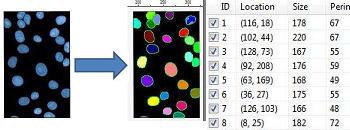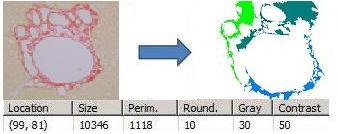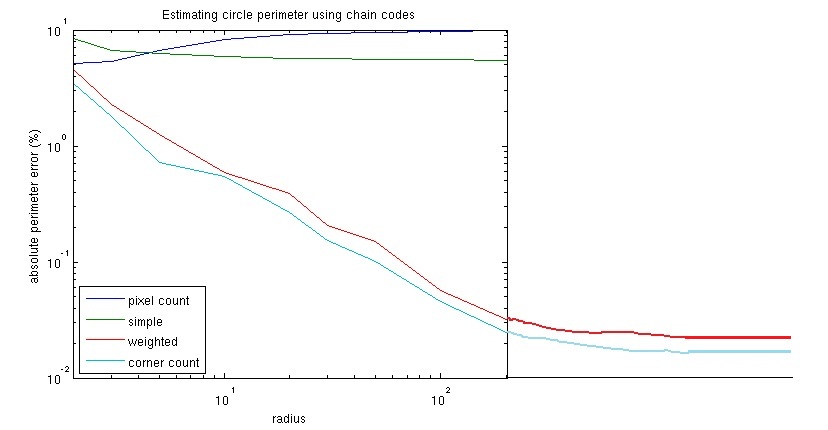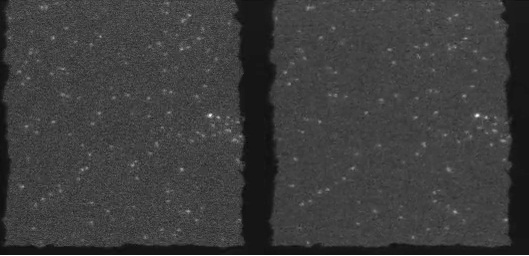The idea behind Pixcavator is this:
Manually counting, measuring, and extracting other data from digital images is often impractical or even impossible.
Pixcavator has helped a lot of people with this problem. But, as easy to use as Pixcavator is, technical difficulties do arise. One is installation and activation. Another comes from the fact that Pixcavator is semi-automatic. It takes some trial-and-error to find the best settings that produce meaningful analysis of your image. Or we can do it for you. That’s what the new service is about.
Since Pixcavator is used, the results are the same. You receive the analyzed image with contours that capture the features you are looking for, and Excel spreadsheet with all the data about them.


More…
Comments Off
Previously, I had a few posts on the problems and issues of computing the lengths of digital curves. The lessons are summarized in the wiki.
In a recent post Cris Luengo presesnts his view of the issues with some experimental data. The diagram below shows relative errors of four methods of measuring lengths: “The absolute, relative error is plotted in percentages against the disk’s radius (100⋅|P-2πr|/(2πr))”:

I had to extend the graph to make the important point missing from the post: even though some methods improve with incresed resolution, the error does not approach 0.
Comments Off
Q: “The goal is to find the distance between two light emitters that are both within a single pixel. One will go dark after a period of time and the other will go dark after another period of time. …we are looking to see if you see an issues in some of the techniques we are using or can propose better algorithms.”

Let me summarize.
Problem:
- Given a few emitters going on and off, find their coordinates from a video.
Challenges:
- The emitters are blurred forming spikes.
- There is other noise.
- The spikes are just a few pixels in size.
- The sources are sometimes closer than the size of the pixel leading to overlapping spikes.
Main methods:
The main issue is this:
- Averaging the spikes obscures the fact that the coordinates of each spike varies from frame to frame.
How much do they vary? The answer will give you the best possible accuracy of the measurement.
The goal was to test the approach in order to see of it’s possible to track emitters from frame to frame and for that I used Pixcavator. I picked a couple of frames, fairly far apart from each other and converted them to bmp images. I analyzed each with Pixcavator with the same settings. Then I matched the locations. These are the distances between the best matches:
0.30 0.07 0.69 0.15 0.41 0.19 0.92 0.72 0.40 0.60 0.97 0.64 0.15 pixels.
Is this accurate enough?
More details here…
Comments Off
These are three research papers that use Pixcavator I discovered (I wish someone simply let me know somehow…):
- The effect of the hydrocarbon–water interface structure on the behavior of an emulsion stabilized with dodecanephosphonic acid by Valeria Verdinelli, Paula V. Messina, Eduardo N. Schulzb, Daniel Salinas, Bruno Vuano, Pablo C. Schulz, published in Colloids and Surfaces A: Physicochemical and Engineering Aspects.
- Visualizing the mobility and distribution of chlorophyll proteins in higher plant thylakoid membranes: effects of photoinhibition and protein phosphorylation by Tomasz K. Goral, Matthew P. Johnson, Anthony P.R. Brain, Helmut Kirchhoff, Alexander V. Ruban and Conrad W. Mullineaux, published in The Plant Journal.
- The behaviour of double oxide film defects in liquid Al alloys under atmospheric and reduced pressures by R. Raiszadeh, and W.D. Griffiths, published in Journal of Alloys and Compounds.
Comments Off







